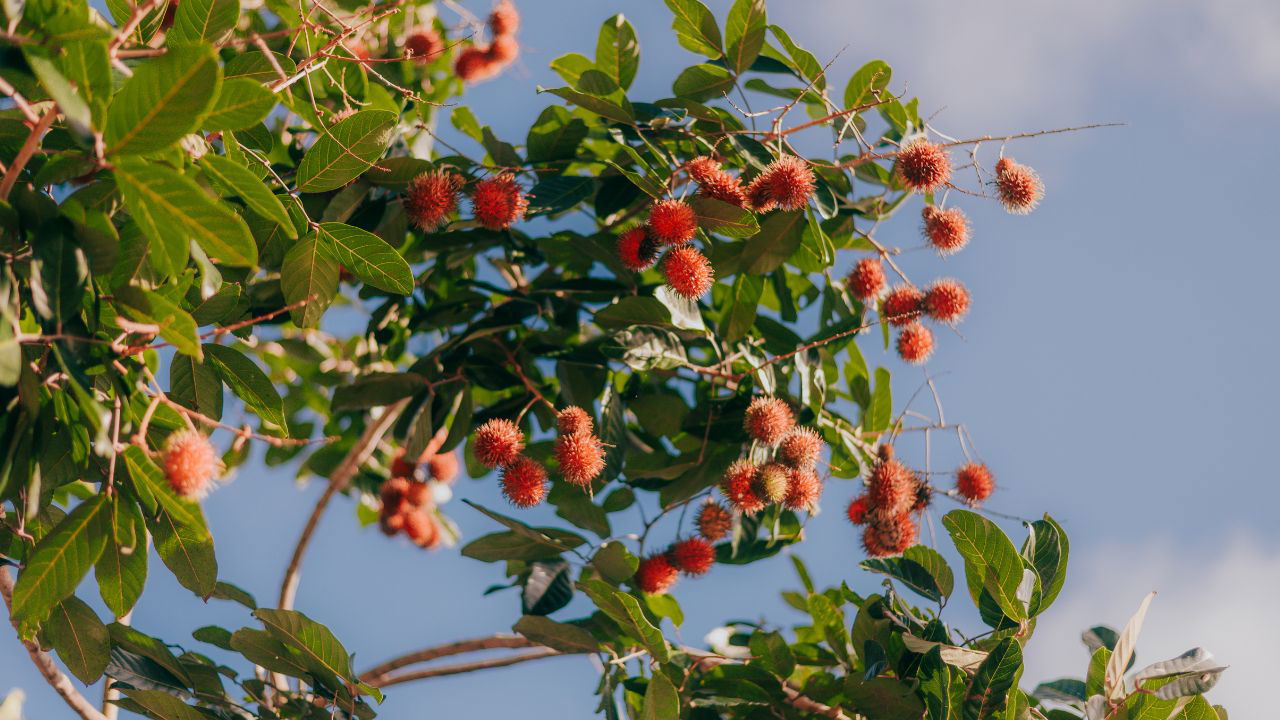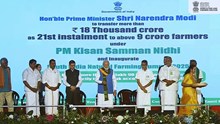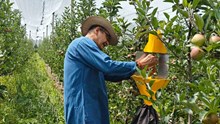
Rambutan (Nephelium lappaceum) is a tropical fruit that has a peculiar hairy exterior skin and succulent, sweet pulp. It is adapted to tropical conditions and native to Malaysia, Indonesia, and Thailand. India's favorable agro-climatic conditions, particularly in the states of Kerala, Karnataka, and Tamil Nadu, offer a good scope for rambutan cultivation. Large-scale production has not yet taken off though its demand is increasing. It is primarily due to the unavailability of quality planting material and long juvenile periods.
If you are considering its taste, then it just tastes like litchi. Rambutan is usually hailed as the twin of litchi, as much in look as in flavor. Under the spiky, red exterior there is a fleshy, transparent fruit and the same sweetness and hint of tanginess from litchi. The sensation is soft and cool and extremely refreshing to the palate on a hot day. Litchi has a sleeker, thin skin, and rambutan is hairy. When you take a bite down and you have the same exact taste. Nature's way, it seems, of giving to us a litchi's tropical equivalent, with a little twist.
New Rambutan Varieties: Arka Coorg Arun and Arka Coorg Pitab
The Indian Institute of Horticultural Research (IIHR), Bangalore, has selected and released two promising rambutan varieties following the screening of fifty accessions at its Central Horticultural Experiment Station (CHES), Chettalli, Karnataka.
-
Arka Coorg Arun (Red-Coloured Variety): It is an early maturing, semi-spreading variety that flowers in February-March and gives deep red, juicy fruits in September-October. The fruit weighs about 40-45g with a free stone aril, thus being more consumer-friendly. The yield per tree is 750-1000 fruits.
-
Arka Coorg Pitab (Yellow-Coloured Variety): It is a high-yielding variety with semi-spreading growth habit, flowering in February-March and October maturity. Fruits are yellow, 25-30g in weight, with white, sweet, and juicy aril. The yield of this variety is approximately 1200-1500 fruits per tree.
Favorable Growing Conditions for Rambutan
Rambutan grows well in a warm, humid environment with temperatures ranging from 22-30°C. It needs well-distributed rainfall of 200-500 cm annually. Sandy loam to clay loam soils with good organic matter content are preferred. The ideal of the soil should be pH of 4.5 to 6.5. The crop is extremely waterlogging-sensitive, and hence planting on slight slopes or raised beds provides improved root health.
Propagation and Planting Techniques
Rambutan can be propagated by seeds or vegetative means such as budding, grafting, and layering. Seed propagation is not advisable for commercial cultivation because most seedlings yield only male flowers. Vegetative propagation techniques such as patch budding are used instead, with success rates of up to 83.6% in certain nations.
Seedlings must be prepared for grafting after 9-10 months. 10x10m to 12x12m spacing is the suggested planting distance for seedling trees, and the vegetatively propagated tree plants have to be planted with 8x8 m or 8x6 m spacing. The ideal time for planting is immediately after the start of the monsoon that is, June or July
Pruning and Fertilization for Improved Yield
Rambutan trees have a high apical dominance and grow erect. Pruning and training at an early stage help in developing an open-centered canopy which will enhance air circulation and fruiting. Fruiting branches must be pruned after harvest to stimulate new growth.
The fertilizer application of 200g nitrogen, 25g phosphate, and 100g potassium per tree per year is suggested for maximum yield. Fertilizers must be given in four equal installments every three months for the first four years. The dose of potassium must be raised to 130g per tree per year after trees begin to fruit. The highest fertilizer requirement is achieved at 12 years and does not change thereafter.
Flowering, Pollination, and Harvesting
Four years are required by rambutan trees to produce fruit if they are grafted. In India, the season for flowering occurs between February and March, while the fruit becomes ripe between July and October. Indian conditions permit only a single harvest annually in contrast to Southeast Asia, where rambutan trees produce twice a year.
Rambutan pollination is mainly cross-pollination by insects. To stimulate fruiting, a short dry spell of 21-30 days prior to flowering is advised. Fruits are almost five months in maturation after pollination. Sharp shears or knives are used in harvesting because fruits are very tender and bruise easily.
Market Demand and Economic Potential
Rambutan is extremely nutritious with a high content of vitamins, minerals, and natural sugars. The majority of fruits are consumed fresh as it is perishable in nature. In India, the fruit price is Rs. 400-500 per kg in retail markets. It makes it a profitable enterprise for farmers. rambutan is also used to make canned goods, squash, and jams In addition to being consumed fresh which generates additional income.
Future Prospects for Rambutan Farming in India
Rambutan cultivation has a bright future in India with increasing demand for exotic fruits. The availability of high-yielding varieties such as Arka Coorg Arun and Arka Coorg Pitab gives enough strength to boost its cultivation. With proper planting materials, training, and support, farmers in the southern states can greatly benefit from the crop. Rambutan has the potential to be a prominent horticultural crop in India in the years to come, considering its value in the market and its health benefits.















